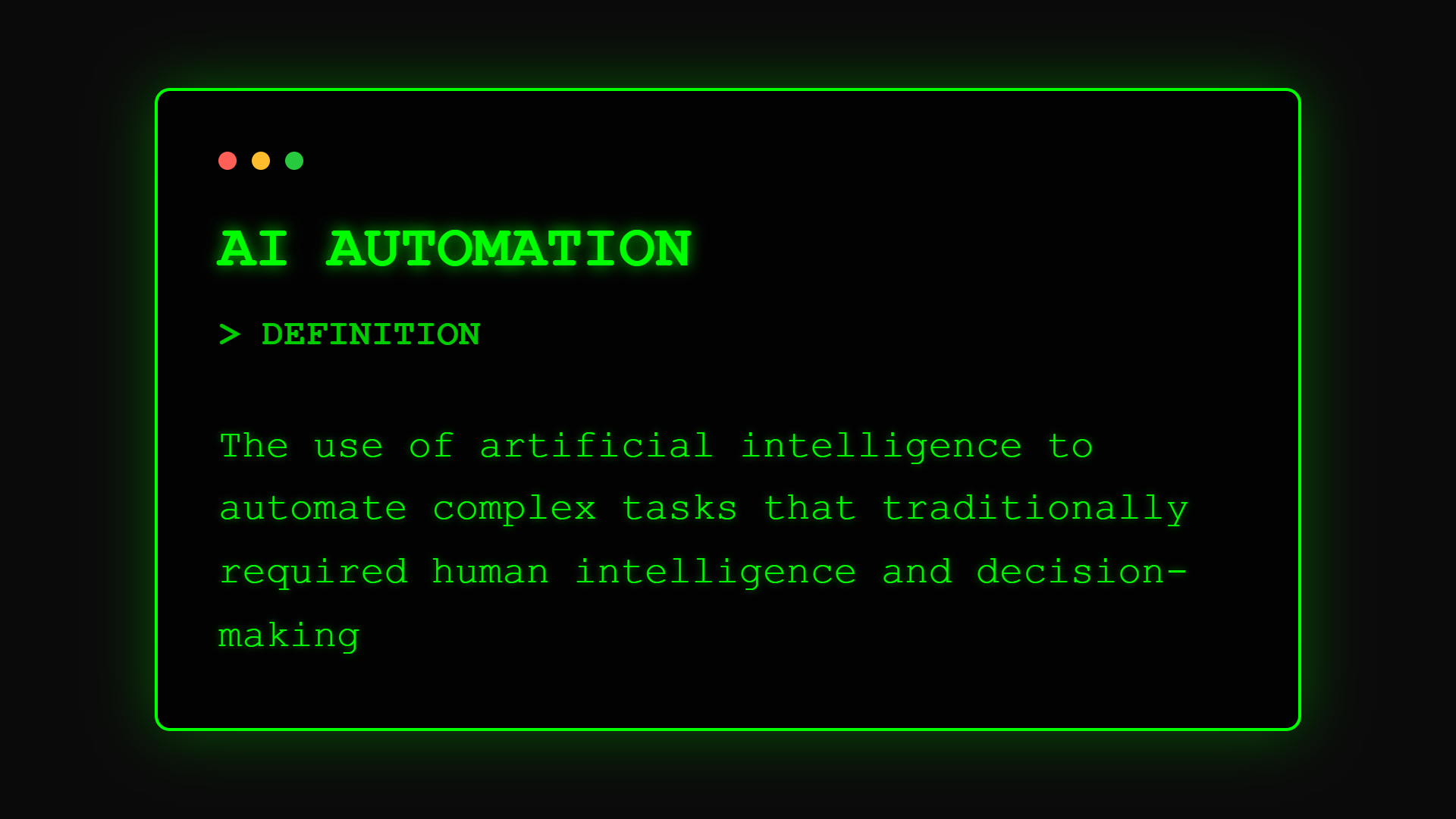AI Terms
What is AI Automation? When Machines Learn to Work Smarter

Your team spends 40% of their time on repetitive tasks that require judgment calls. Traditional automation can't handle these nuanced decisions, but AI automation can. It's the difference between a robot that follows a script and an assistant that actually understands what needs to be done.
Technical Origins and Definition
According to the IEEE (Institute of Electrical and Electronics Engineers), AI automation is defined as "the application of artificial intelligence techniques to automate tasks that traditionally required human cognitive functions, including perception, reasoning, learning, and decision-making."
The term emerged in the early 2010s as machine learning capabilities matured beyond academic research. Initially, "automation" meant rule-based systems following if-then logic. The addition of "AI" fundamentally changed this, introducing systems that could handle ambiguity, learn from outcomes, and adapt their behavior.
Today's technical definition encompasses any system that combines artificial intelligence algorithms with automated execution capabilities, enabling machines to perform tasks that require understanding context, making judgments, and improving performance over time.
Translating to Business Value
For business leaders, AI automation means systems that can handle complex, judgment-based tasks without constant human oversight, learning and improving as they work.
Think of it as the difference between a basic calculator and a financial advisor. The calculator follows fixed rules; the advisor understands context, makes recommendations, and learns from experience. AI automation brings that advisor-level intelligence to your operational processes.
In practical terms, this translates to software that can read unstructured documents, understand customer intent, make nuanced decisions, and execute appropriate actions, all while getting better at its job over time.
Five Core Components
AI automation consists of these essential elements:
• Artificial Intelligence Engine: The "brain" that processes information, recognizes patterns, and makes decisions based on training and experience
• Automation Framework: The "hands" that execute actions across systems, from sending emails to updating databases to triggering workflows
• Learning Mechanism: The continuous improvement system that monitors outcomes, identifies successful patterns, and refines decision-making
• Integration Layer: The connective tissue that links AI capabilities to existing business systems and data sources
• Human Interface: The control panel where humans set parameters, review exceptions, and provide feedback to improve the system
How AI Automation Functions
The AI automation process follows these steps:
Input & Understanding: The system receives data (emails, documents, images, voice) and uses AI to understand meaning and context, not just keywords
Analysis & Decision: AI algorithms analyze the input against learned patterns, considering multiple factors to determine the best action - like a human would, but faster
Execution & Learning: The system executes the chosen action, monitors the result, and updates its knowledge base to make better decisions next time
This creates a feedback loop where the system continuously improves its performance, unlike traditional automation that remains static regardless of outcomes.
Three Types of AI Automation
AI automation generally falls into three main categories:
Type 1: Cognitive Automation Best for: Document processing, email handling, content generation Key feature: Understanding and processing human language and unstructured data
Type 2: Visual Automation Best for: Quality control, security monitoring, inventory management Key feature: Interpreting images and video to make decisions and trigger actions
Type 3: Predictive Automation Best for: Maintenance scheduling, demand forecasting, risk assessment Key feature: Anticipating future needs and taking preemptive action
AI Automation Examples
Here's how businesses actually use AI automation:
Customer Service Example: Zendesk implemented AI automation to handle customer tickets, achieving 90% accurate routing and 60% reduction in response time by understanding intent rather than just keywords.
Finance Example: JP Morgan's COIN platform uses AI automation to review commercial loan agreements in seconds—a task that previously took 360,000 hours of lawyer time annually.
Manufacturing Example: BMW uses AI-powered visual automation to inspect painted surfaces, catching 97% of defects while reducing inspection time by 30%.
Each example shows AI making judgment calls—understanding context, recognizing patterns, and deciding appropriate actions—not just following predetermined rules.
Start Your Automation Journey
Ready to apply AI automation in your business?
- Start with our AI Readiness Assessment to identify your best opportunities
- Explore Robotic Process Automation (RPA) to understand the foundation technology
- See how Machine Learning powers intelligent decision-making
- Learn implementation strategies in our AI Automation Playbook
FAQ Section
Frequently Asked Questions about AI Automation
Part of the [AI Terms Collection]. Last updated: 2025-01-10